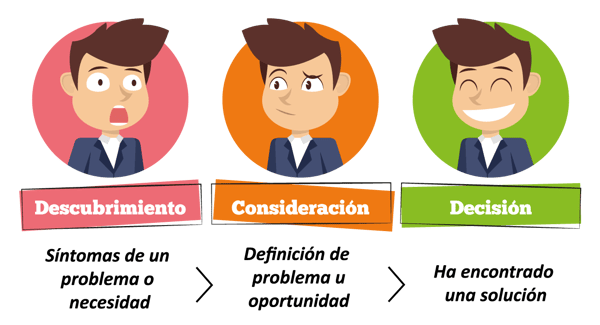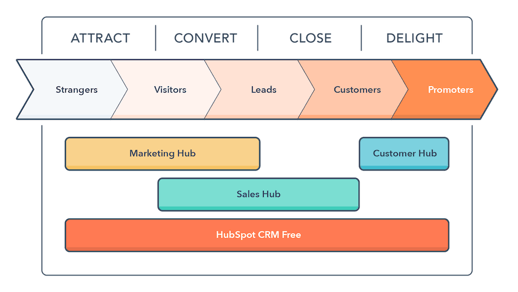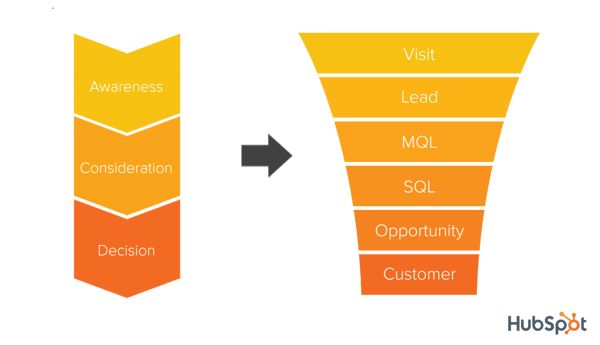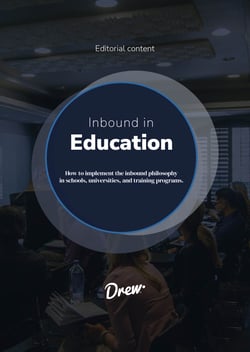
Inbound in education
Radical changes
The purchasing process in the education sector has changed markedly.
Young people interested in education, careers, short courses, specializations, etc. dedicate themselves to research and seek educational offers. Today a young man sits on his computer and begins to search for what he would be interested in studying. He seeks information, raises doubts, makes consultations, until he finds the solution and is ready to start studying that specific career that adapts to his profile, but educational entities do not focus on this for now, which is an opportunity.
- Increase the number of students per program.
- Retain students to finish the course.
- Detect up-sell or cross-sell opportunities in different students.
- Achieve a greater customization.
What do we are Drew do to overcome these challenges?
What are buyers looking for?
High school students: they are in full search and exploration of their professional future. They are comparing the different career possibilities available to find an academic proposal that suits their interests.
University graduates: they already have a professional degree, but they are looking for instruction in a particular branch within their discipline, and that is why they are interested in graduate studies.
Postgraduate graduates: here are those interested in masters, doctorates. They seek to be specialists within a particular area of their discipline.
Inbound Marketing’s methodology is excellent for the education sector. It serves mainly for the first stage of the buyer’s journey, the exploration, since it has at the disposal of the buyer person all the information that they need to solve their problem of, for example, which career to study. All the content available to those interested will be at their fingertips and will lead them along a progressive path that will help them decide which academic option best suits them and, in turn, will give a new student to the institution.
What actions do the industry do?
The education sector is increasingly suffering from the growth of competition, and this means that different institutions need to put in place original strategies to achieve greater student recruitment. In this sense, communication is the key. Having innovative, personalized and targeted communication strategies for different types of audiences became a necessary aspect if you want to be successful.
Moreover, the process of an educational institution does not end when it manages to capture a new student, but there a new path begins.
Luego de cerrar con ese nuevo alumno, el establecimiento debe poner en marcha las estrategias de retención para que este termine sus estudios, y posterior deleite (volver a atraerlo) para que continúe especializándose dentro de esa misma institución.
Todo esto se puede lograr si la institución se compromete con el proceso que propone la metodología de Inbound Marketing, que sirve tanto para ellos como así también para los alumnos, porque se sentirán acompañados, ayudados, importantes para la institución.
Inbound marketing in education

Now if, once we have this clear, we start with the methodology Inbound.

It is a model of growth, which seeks to generate a machine of creation of students and opportunities. As more time passes, better results are seen. There is even a study by a student at MIT that scientifically reveals the results of using an inbound strategy.
Strategy development
Suppose your name is Paula and you are the sales manager of a university with more than 30 years of experience. Given the high level of competence in the education sector, you are faced with the problem that you need to increase the number of annual enrollments, improve the enrollment rate to the different careers offered.
Discovery: How can I increase my college enrollment rate?
This type of problem has a high monthly search rate in Google, which is growing more and more.
In this first stage of discovery people are only looking for information to know how they can solve their problem. I mean, they know what they want to do, but they don’t know or they’re not sure how to do it. So, that’s where there is a new business opportunity, to help these people solve their problems in a clear and strategic way, where the relationship is prioritized, the students and so that company and client see mutually beneficial.
Having this in mind, we move on to the following... How to get their attention?
The content will be more specific and personalized as you go through the phases. The phases are: TOFU (Top of funnel = Top of funnel) / MOFU (Middle of funnel = Middle of funnel), BOFU (Bottom of funnel = Bottom of funnel).
TOFU content is for someone who is in the discovery stage, while MOFU content is for a person who is considering solving their problem (consideration stage), and finally, a BOFU is for someone who is already decided or about to make the purchase decision.

Example strategy
TOFU
Imagine that you are a high school student and have the problem that you do not know what to study, then you do a search and find in Google an article that says: "What you need to consider to define your professional future". Won’t you like reading it? Sure!
Even, at the end of the article, you find a button that says: "Access the free vocational test to find your passion".
Article TOFU: What you need to consider to define your professional future
Download TOFU: Vocational test
Data to ask in return:
- First name
- Date of birth
- You finished high school?
- If Not
- If the answer is yes... how long?
- If the answer is no... what year are you in?
Then, weeks later you get a personalized email that talks about the subject according to your choice based on the question Have you finished high school? and in the mail they recommend a one-off article about "Hello! Look at the 5 reasons why studying a degree is a good choice", but the best thing is that at the end of the article there is a button that says: "Comparative duration and cost of each degree race"
WOW! Ahi it catches your attention much more, because it was just what you had doubts, you feel very identified with this, you want to read the document, and you download it. But sure, with a little more key data they ask for.
Article MOFU: 5 reasons why study a degree.
Downloadable MOFU: Comparative length and cost of each degree course
Data to ask in return:
What are you planning to study?
-
Lic. Adm of companies
-
Lic. Foreign trade.
-
Accounting.
-
(List all races).
-
Other
- Telephone
- City
- What’s your biggest challenge?
- I don’t have enough money for a degree
Prove to my family that I can finish a career.
Be a professional received.
Dedicate myself and live in what I love.
- In a month.
- Between 1 to 3 months.
- Three to six months.
- Six to 12 months.
- One year from now.
They don’t even know the sales reps and they already know everything about us and our programs, courses, careers, etc. So it is today
If a person, completed all the items we requested (In exchange for something valuable), from TOFU, and MOFU, we already practically know if they will buy us not. Right?
But beyond that, we have created a bond.
Then, at this stage, you are with several ideas in your head, you realize that you already feel an affection for us, because for 2 months we know each other and we never try to sell you. (That seems strange, and you like) so you just get an email that says, "Shall we talk?" You open it, you go in, you see a schedule of meetings to have a conversation with Andrés, an advisor from our university. Agendas, and that’s it.
SALES
Selling without selling: Building true relationships
- 10 keys to building trust with your students.
- Preparation: The key to a successful sale.
- How does the buyer journey affect your sales?
- 10 ways to start a successful sales call.
- Does it cost to sell real estate? Look at these strategies.
- Like making a successful real estate sale.
.
Learn all about inbound in education
